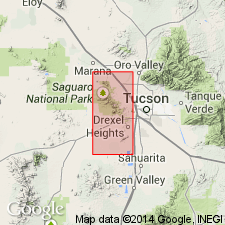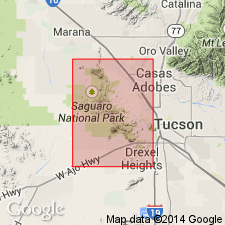
- Usage in publication:
-
- Amole latite
- Modifications:
-
- Original reference
- Dominant lithology:
-
- Latite
- Quartz monzonite
- AAPG geologic province:
-
- Basin-and-Range province
Summary:
Pg. 710 (fig. 2), 725-726, pl. 1. Amole latite. An intrusive on top of Amole Peak [center sec. 30, T. 13 S., R. 12 E., Lat. 32 deg. 16 min. 20 sec. N., Long. 111 deg. 09 min. 18 sec. W., Avra 7.5-min quadrangle, Pima County, Saguaro National Park, Tucson Mountains, southeastern Arizona]. Occurs in series of roughly east-west fingers extending eastward from [Amole] quartz monzonite. Latite is intrusive as sills into Cretaceous sedimentary rocks. It shows extreme variety. Commonest is dense felsitic rock with inconspicuous phenocrysts of quartz and feldspar and abundant xenoliths of arkose and other Cretaceous sedimentary rocks. Elsewhere, rock is coarsely felsitic and so full of fine-grained inclusions that it closely resembles invaded arkoses. No gradational contacts with [Amole] quartz monzonite have been found. [Age is Late Cretaceous and (or) Tertiary] (Laramide).
Area: Tucson Mountains, southeastern AZ. City of Tucson is located at east base of central part of range.
Source: US geologic names lexicon (USGS Bull. 1200, p. 83-84).

- Usage in publication:
-
- Amole latite†
- Modifications:
-
- Abandoned
Summary:
Abandoned. Replaced by nonwelded to partly welded rhyolite unit (map unit Kcn) of Cat Mountain Tuff (revised). Unit Kcn is light gray to tan tuff, lacking well developed compaction foliation; is conspicuously developed at top of Cat Mountain Tuff where it is 50-100 m thick and also occurs within and adjacent to megabreccia lenses and irregular masses. Where unit Kcn is hornfelsed near Amole pluton in northern Tucson Mountains, Pima Co, AZ, Basin-and-Range province, rocks were previously misinterpreted as irregular intrusions and designated Amole latite by Brown (1939) [author uses original spelling "Amole latite" of Brown (1939)]; name has no significance and should be abandoned.
Source: GNU records (USGS DDS-6; Denver GNULEX).
For more information, please contact Nancy Stamm, Geologic Names Committee Secretary.
Asterisk (*) indicates published by U.S. Geological Survey authors.
"No current usage" (†) implies that a name has been abandoned or has fallen into disuse. Former usage and, if known, replacement name given in parentheses ( ).
Slash (/) indicates name conflicts with nomenclatural guidelines (CSN, 1933; ACSN, 1961, 1970; NACSN, 1983, 2005, 2021). May be explained within brackets ([ ]).

